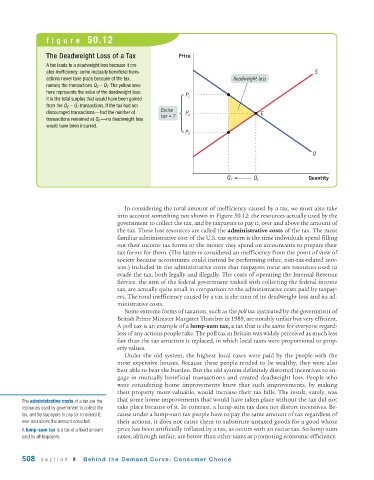Page 550 - Krugmans Economics for AP Text Book_Neat
P. 550
figure 50.12
The Deadweight Loss of a Tax Price
A tax leads to a deadweight loss because it cre-
ates inefficiency: some mutually beneficial trans- S
actions never take place because of the tax, Deadweight loss
namely the transactions Q E − Q T . The yellow area
here represents the value of the deadweight loss:
P C
it is the total surplus that would have been gained
from the Q E − Q T transactions. If the tax had not
Excise
discouraged transactions—had the number of E
tax = T P E
transactions remained at Q E —no deadweight loss
would have been incurred.
P P
D
Q T Q E Quantity
In considering the total amount of inefficiency caused by a tax, we must also take
into account something not shown in Figure 50.12: the resources actually used by the
government to collect the tax, and by taxpayers to pay it, over and above the amount of
the tax. These lost resources are called the administrative costs of the tax. The most
familiar administrative cost of the U.S. tax system is the time individuals spend filling
out their income tax forms or the money they spend on accountants to prepare their
tax forms for them. (The latter is considered an inefficiency from the point of view of
society because accountants could instead be performing other, non-tax-related serv-
ices.) Included in the administrative costs that taxpayers incur are resources used to
evade the tax, both legally and illegally. The costs of operating the Internal Revenue
Service, the arm of the federal government tasked with collecting the federal income
tax, are actually quite small in comparison to the administrative costs paid by taxpay-
ers. The total inefficiency caused by a tax is the sum of its deadweight loss and its ad-
ministrative costs.
Some extreme forms of taxation, such as the poll tax instituted by the government of
British Prime Minister Margaret Thatcher in 1989, are notably unfair but very efficient.
A poll tax is an example of a lump-sum tax, a tax that is the same for everyone regard-
less of any actions people take. The poll tax in Britain was widely perceived as much less
fair than the tax structure it replaced, in which local taxes were proportional to prop-
erty values.
Under the old system, the highest local taxes were paid by the people with the
most expensive houses. Because these people tended to be wealthy, they were also
best able to bear the burden. But the old system definitely distorted incentives to en-
gage in mutually beneficial transactions and created deadweight loss. People who
were considering home improvements knew that such improvements, by making
their property more valuable, would increase their tax bills. The result, surely, was
The administrative costs of a tax are the that some home improvements that would have taken place without the tax did not
resources used by government to collect the take place because of it. In contrast, a lump-sum tax does not distort incentives. Be-
tax, and by taxpayers to pay (or to evade) it, cause under a lump-sum tax people have to pay the same amount of tax regardless of
over and above the amount collected. their actions, it does not cause them to substitute untaxed goods for a good whose
A lump-sum tax is a tax of a fixed amount price has been artificially inflated by a tax, as occurs with an excise tax. So lump-sum
paid by all taxpayers. taxes, although unfair, are better than other taxes at promoting economic efficiency.
508 section 9 Behind the Demand Curve: Consumer Choice

